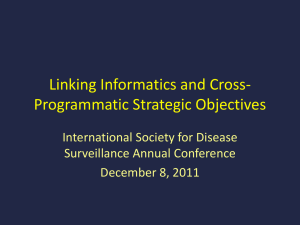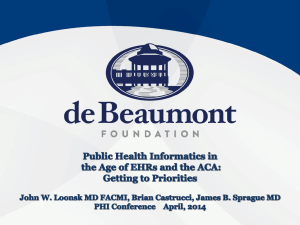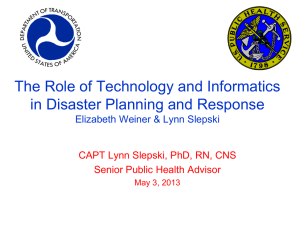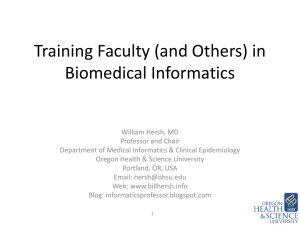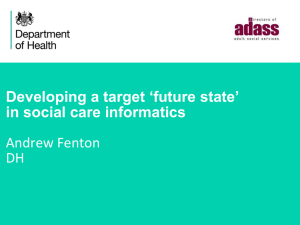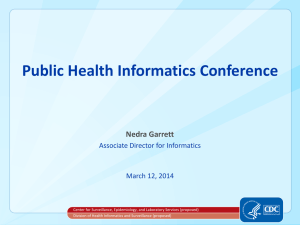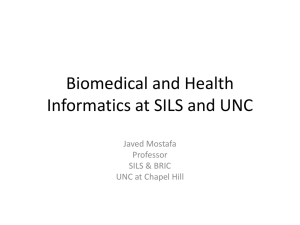Biomedical Informatics
advertisement
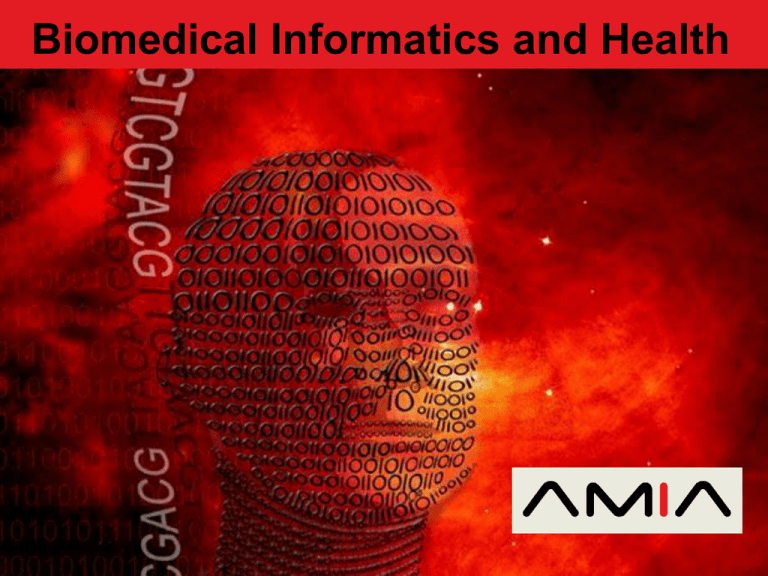
Biomedical Informatics and Health Biomedical Informatics: Assessing the Science as Well as the Pragmatics Edward H. Shortliffe, MD, PhD President and CEO, AMIA, Bethesda, MD Professor of Biomedical Informatics, UTexas Houston Mexico City, Mexico March 2, 2011 www.amia.org A Tale of Two Worlds…. Modern Commerce Modern Health Care Concern: Computers are too mechanical. They will depersonalize the process of health care delivery…. "I'd object to any use of the computer that eliminated or minimized the physician-patient relationship to the point where you lost rapport and the interaction became impersonal." Concern: Clinicians will be judged by the way in which they use computers in their practices (or by their failure to do so)……. Some Questions for Discussion • What is the field of biomedical informatics? • What is its scientific base, and how does it relate to health information technology? • Why is it important for health professionals to learn something about this field? • What are typical questions that arise in practice for which informatics training would be valuable? • What is the current status of the field and its evolving role in clinical care and public health? www.amia.org What is “Biomedical Informatics”? Historical Perspective • Seminal article: Earliest broad recognition of statistical issues in diagnosis and the potential role of computers occurred in the late 1950s • “Reasoning foundations in medical diagnosis”: Classic article by Ledley and Lusted appeared in Science in 1959 • Computers began to be applied in biomedicine in the 1960s • Most applications dealt with clinical issues, including diagnostic systems www.amia.org Historical Perspective • “Computers in medicine” in the 1960s • First Federal grant review group • Most applications dealt with clinical issues • No consistency in naming the field for many years • “Computer applications in medicine” • “Medical information sciences” • “Medical computer science” • Emergence in the 1980s of a single, consistent name, derived from the European (French) term for computer science: informatique • Medical Informatics www.amia.org “Fundamental Theorem” of BMI From: Charles P. Friedman. J Am Med Inform Assoc. 2009;16:169 –170. www.amia.org “Fundamental Theorem” of BMI From: Charles P. Friedman. J Am Med Inform Assoc. 2009;16:169 –170. www.amia.org Terminology Confusion • • • • • • • Informatics? Medical informatics? Bioinformatics? Health informatics? Biomedical informatics? Public health informatics? <insert adjective> informatics? www.amia.org Biomedical Informatics Biomedical informatics (BMI) is the interdisciplinary field that studies and pursues the effective uses of biomedical data, information, and knowledge for scientific inquiry, problem solving, and decision making, motivated by efforts to improve human health. www.amia.org Biomedical Informatics: Corollaries to the Definition 1. BMI develops, studies and applies theories, methods and processes for the generation, storage, retrieval, use, and sharing of biomedical data, information, and knowledge. 2. BMI builds on computing, communication and information sciences and technologies and their application in biomedicine. www.amia.org Biomedical Informatics: Corollaries to the Definition 3. BMI investigates and supports reasoning, modeling, simulation, experimentation and translation across the spectrum from molecules to populations, dealing with a variety of biological systems, bridging basic and clinical research and practice, and the healthcare enterprise. 4. BMI, recognizing that people are the ultimate users of biomedical information, draws upon the social and behavioral sciences to inform the design and evaluation of technical solutions and the evolution of complex economic, ethical, social, educational, and organizational systems. www.amia.org Biomedical Informatics in Perspective Basic Research Biomedical Informatics Methods, Techniques, and Theories Biomedical Informatics ≠ Bioinformatics Bioinformatics Applied Research And Practice Imaging Informatics Clinical Informatics Public Health Informatics Interdisciplinary Nature of Biomedical Informatics Computer Science (software) Computer Science (hardware) Cognitive Science & Decision Making Bioengineering Biomedical Informatics Epidemiology And Statistics Management Sciences Clinical Sciences Basic Biomedical Sciences www.amia.org Biomedical Informatics in Perspective Basic Research Biomedical Informatics Methods, Techniques, and Theories Biomedical Informatics ≠ Health Informatics Health Informatics Bioinformatics Imaging Clinical Informatics Informatics Public Health Informatics Tissues and Organs Populations And Society Applied Research And Practice Molecular and Cellular Processes Individuals (Patients) Biomedical Informatics in Perspective Basic Research Biomedical Informatics Methods, Techniques, and Theories Pharmacogenomics Biomolecular Imaging Bioinformatics Applied Research And Practice Consumer Health Imaging Clinical Informatics Informatics Public Health Informatics Molecular and Tissues and Individuals Populations Cellular ContinuumOrgans with “Fuzzy” Boundaries (Patients) And Society Processes Biomedical Informatics in Perspective Basic Research Biomedical Informatics Methods, Natural Techniques, and Theories Database Cognitive Language Math Data Statistics Mining Modeling Theory Science Processing Applied Research And Practice Bioinformatics Imaging Clinical Informatics Informatics Molecular and Cellular Processes Tissues and Organs Individuals (Patients) Public Health Informatics Populations And Society Biomedical Informatics in Perspective Contribute to... Biomedical Informatics Methods, Techniques, and Theories Other Management Information Computer Decision Cognitive Component Sciences Science Science Sciences Draw upon…. Contributes to…. Applied Informatics Draws upon…. Clinical or Biomedical Domain of Interest Education of Biomedical Informatics Researchers Basic Research Biomedical Informatics Methods, Techniques, and Theories Education and Experience at Both Levels Contributions Expected Bioinformatics Applied Research And Practice Imaging Informatics Clinical Informatics Public Health Informatics Biomedical Informatics Textbook (3rd edition) Springer Verlag Verlag - -2006 Springer 2006 Bio A Key Limitation As We Seek To Bring Informatics into Clinical Care There are too few people trained at the interface between computer, information, and communication sciences with the biomedical and health sciences Responses: • Degree programs in biomedical informatics • Informatics training in health professional schools • Certificate and continuing education programs in informatics for health professionals • Joint degree programs for MD or nursing students • Fellowships and board certification in biomedical informatics for physicians www.amia.org The Last 40 Years • Biomedical informatics training programs at several universities • Creation of professional societies, degree programs, quality scientific meetings, journals, and other indicators of a maturing scientific discipline • Broadening of applications base, but with a tension in academia between the field’s service role and its fundamental research goals www.amia.org Academic Units in Biomedical Informatics • Tend to have arisen as grass roots activities, stimulated by individual, interested faculty members • Most are based in medical schools • May be centers, institutes, divisions in other departments or, increasingly, stand alone departments • Tend to have characteristics of both basic science and clinical departments • At many institutions, have clinical systems design and implementation responsibilities • Many have graduate trainees (masters and PhD) and postdoctoral fellowships • Units tend to have both research- and service-oriented faculty members www.amia.org What Do Informatics Graduates Do? Academic biomedical informatics Industrial R&D in biomedical informatics Librarianship and knowledge management Public health with informatics emphasis Biotechnology / Pharmaceuticals Clinical practice (with some informatics) Hospitals (Clinical computing) Government (Research or hospitals) Further clinical training www.amia.org BMI and HIT (Health Information Technology) Clinical Systems Companies Biomedical Informatics Training, Research and Development • Academia • Research Institutes • Corporate Research Labs Hospitals, Health Systems, Practices, IDEAS PEOPLE METHODS SOFTWARE Healthcare Industry Academic Medical Centers Biomedical Research Community BMI and HIT (Health Information Technology) Clinical Systems Companies Biomedical Informatics Training, Research and Development • Academia • Research Institutes • Corporate Research Labs Synergies Hospitals, Health Systems, Practices, Healthcare Industry Academic Medical Centers AMIA: The Professional Home for Biomedical and Health Informatics US-based but many international members Opportunities to Learn about BMI • Continuing Education Programs at national & international meetings • Tutorials at AMIA Annual Symposium • “10 X 10” Courses offered by AMIA • Online courses • Most lead to certificates • Some can be part of distance learning for graduate degrees • Latin American course (adapted and translated from Oregon course) being offered in Argentina www.amia.org Education of Health Professionals Basic Research Biomedical Informatics Methods, Techniques, and Theories Limited Exposure to Methods Education and Experience at Applied Level Bioinformatics Applied Research Imaging Informatics Clinical Informatics Public Health Informatics Some Questions • Given that I can’t memorize everything, what’s the best way for me to find the information that I need in a timely fashion, with suitable attention to its accuracy and completeness? • What is e-prescribing? How will it work from my future private practice setting? How will I direct prescriptions to the correct pharmacy? How will I reduce the chance of errors? • What is syndromic surveillance? How will it affect me in my practice? What is it important to society? How will it work? www.amia.org More Questions • How should I assess the various electronic medical record systems available to me in my practice? Those under consideration by my hospital? • Why should I care about standardization of terminology? Of communication methods? • Why is biomedical informatics crucial to the concept of “personalized medicine”? How do biological applications (bioinformatics) support this same concept? www.amia.org And More Questions • To what extent is modern biological research feasible without the use of informatics tools and concepts? • How does cognitive science help me to understand the basis for miscommunication and confusion at the interface between me and my patients? What is the difference between my “mental models” and those of my patients? Why do those differences matter? How should I adjust my personal style to take those into account? www.amia.org Still More Questions • Why are clinical information systems often rejected by physicians? Are they worth the effort? Why or why not? • How can I best use the clinical data available to me for a patient, and my background knowledge of tests and their utility, to guide me in interpreting test results and guiding therapy? • Why do consultants give us differing advice, even when we all agree on the facts? • In what sense is biomedical informatics one of the basic sciences intrinsic to medical training and practice? www.amia.org Screening Test for Occult (Unseen) Cancer 100 patients with occult cancer: 95 have "x" in their blood SENSITIVITY 100 patients without occult cancer: SPECIFICITY 95 do not have "x" in their blood 5 out of every 1000 randomly selected individuals will have occult cancer PREVALENCE If an individual in the community is tested and is found to have “x” in his blood, what is the chance he has an occult cancer? PREDICTIVE VALUE Informatics as a Clinical Specialty • American Board of Medical Specialties (ABMS) application to create formal subspecialty fellowships and board exams for physicians • Effort sponsored by American Board of Preventive Medicine and American Board of Pathology • Unlike other subspecialty boards, the proposal is that the Clinical Informatics subspecialty will be available to physicians regardless of their primary board (surgery, medicine, family practice, pediatrics, etc.) • Accreditation Program Requirements for Fellowships www.amia.org Trends In The USA (and beyond?) • Creation of several new biomedical informatics departments or independent academic units • Strong job market for graduates of informatics degree programs • Government investment in training and research • Increasing acceptance of biomedical informatics as a subspecialty area by biomedical professional societies • Increasing recognition that biomedical problems can drive the development of basic theory and capabilities in information technology research www.amia.org A Key Lesson from 40 Years of Clinical System Design and Implementation Widely accepted appreciation that successful systems are not about the technology but about the people, the culture, and the processes that are in place, replaced, or created www.amia.org Envisioned Cycle That Has Motivated The Work Electronic Health Records Biomedical and Clinical Research Regional and National Public Providers Health and Caring for Disease Patients “Meaningful Use”? Registries Standards for Prevention Information, Creation of and Decision-Support, Protocols, Treatment and Order-Entry Guidelines, Systems and A “Learning Educational Healthcare Materials System” Institute of Medicine 287 pages (April 15, 2000) Institute of Medicine 364 pages (July 2001) Information Technology Infrastructure • IT Infrastructure viewed as fundamental to achieving the six quality aims • safety • effectiveness • patient-centeredness • timeliness • efficiency • equity www.amia.org Institute of Medicine 550 pages (May 2004) “The committee believes that establishing this information technology infrastructure [NHII] should be the highest priority for all health care stakeholders.” Committee on Data Standards for Patient Safety (Executive Summary) White House at night President Bush calls for universal implementation of electronic health records within 10 years -www.amia.org 2004 “Dr Obama” Aims to Treat the US Economy … …and the US healthcare system! www.amia.org The Recovery Act’s HIT Expenditures 2009 American Recovery and Reinvestment Act (ARRA) • $19 billion healthcare technology (HIT) spending via Centers for Medicare & Medicaid Services (CMS) for adoption of EHR systems • $17 billion for incentives (administered by CMS) for providers and hospitals to implement an EHR by 2015 www.amia.org An Optimistic Perspective A spokeswoman from the Department of Health and Human Services has cited a Congressional Budget Office estimate that 90 percent of doctors would be using health IT by 2019, thanks to the stimulus bill www.amia.org Looking to the Future • Need for clinicians and biomedical scientists who understand informatics concepts • Need for informatics scientists who can function effectively as scholarly collaborators with clinicians and life scientists • Integrative role of informatics, which touches essentially all areas of biomedicine, clinical care, and public health www.amia.org 2 X 2 Table "x" present "x" absent Occult Cancer Present 475 25 500 Occult Cancer Absent 4,975 94,525 99,500 5,450 94,550 100,000 If a patient has “x” in his blood, chance of occult cancer is 475 / 5450 = 8.7% Positive Predictive Value Formula (Sens)(Prev) PV+ = (Sens)(Prev) + (1-Spec)(1-Prev) This is a form of the statistical relationship known as Bayes’ Theorem www.amia.org Thank You! shortliffe@amia.org Biomedical Informatics and Health

